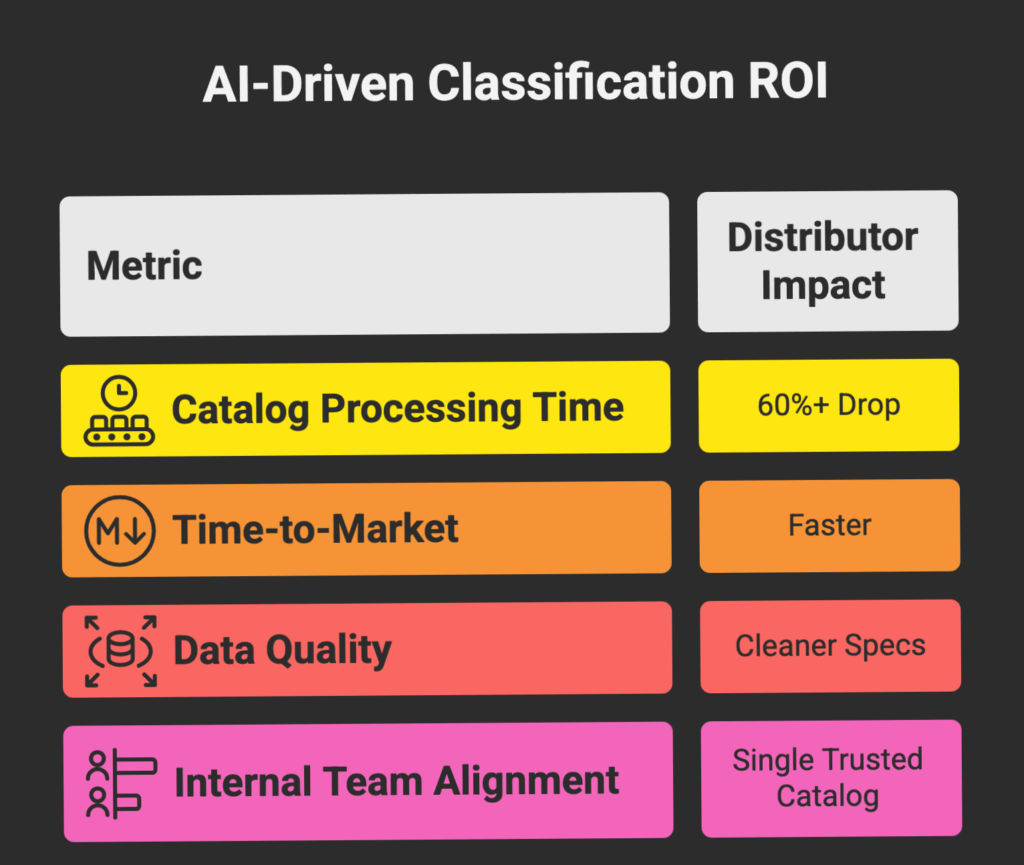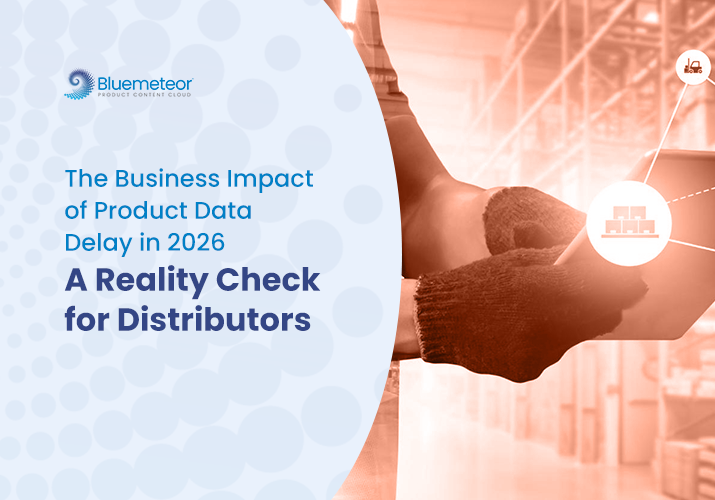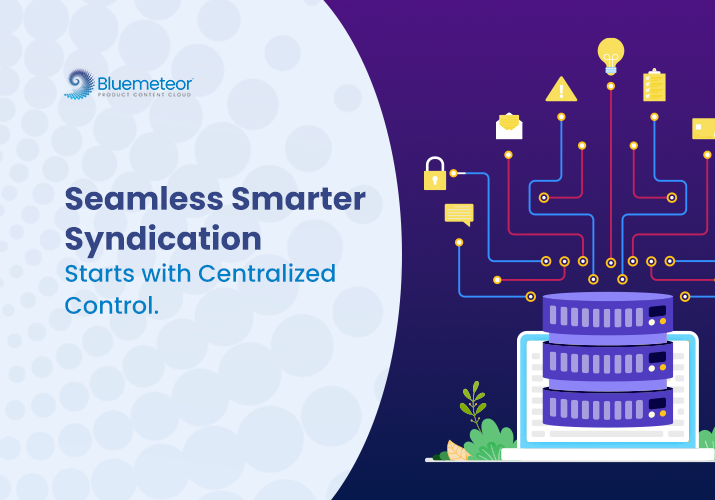Understanding AI-Based SKU Classification: Stop Cleaning, Start Competing

Distributors lose margin in the weeds, not because of pricing. Not because of competitors, but because product data is broken. SKUs are duplicated, miscategorized, missing key specs and most teams are still trying to fix this manually. That’s not a scalable strategy. AI-based SKU classification is how modern distributors fix their catalogs for good. Not in theory, in practice, at scale.
This post breaks down what it is, how it works, and how you can stop wasting hours on manual cleanup and start getting products live faster, cleaner, and more profitably.
SKU Classification as Operational Leverage in Distribution
Your entire sales engine runs on your SKUs. When they’re classified accurately, your processes move faster. When they’re misclassified, everything slows down: quoting, fulfillment, search, and customer service.
Effective SKU classification ensures:
- Consistent naming conventions
- Structured and searchable attributes (voltage, size, material)
- A taxonomy that aligns across web, PIM, and ERP systems
- Clean, deduplicated listings ready for every sales channel
Manual cleanup works, until it doesn’t. By then, you’ve already lost revenue, wasted time, and stressed your team. Therefore, it pays to fix it at the root.
How AI-Based SKU Classification Works in Practice
AI-based SKU classification isn’t about replacing people. Instead, it’s about eliminating the repetitive, low-value tasks that quietly drain time and introduce risk, so your team can focus on work that actually moves the business forward.
Here’s how the process typically works:
- First, the AI engine automatically classifies new SKUs based on your existing taxonomy and business logic. Whether you group products by use case, customer segment, or technical specification, the system learns how you structure your catalog and applies it instantly to new entries.
- Next, it scans for duplicate SKUs, misclassifications, and incomplete product records. This includes catching issues like similar products with inconsistent naming, or items assigned to the wrong category due to inconsistent vendor data.
- Then, for SKUs with missing information – like dimensions, voltage, compatibility, or images, the AI enriches the data using a combination of trusted sources: your supplier files, public product databases, or historical patterns in your existing catalog.
- Finally, instead of making assumptions where it shouldn’t, the system flags edge cases or unusual records for human review. This keeps you in control while dramatically reducing the number of manual decisions your team needs to make.
As a result, your internal resources are no longer stuck cleaning up spreadsheets or reconciling product feeds. They’re freed up to do what people do best: make judgment calls, improve content quality, and execute strategic decisions that impact revenue.
Why Manual SKU Classification Doesn’t Scale Today
Most SKU classification is stuck in a loop of reactive, short-term fixes. It usually starts like this:
- A supplier sends over a catalog feed in a new format
- Someone on the data or ops team creates a one-off cleanup spreadsheet
- They take their best guess, based on tribal knowledge or last year’s file
- The update is pushed live and the errors are discovered later by Sales or Support when a customer complains or can’t find what they need
It’s a firefighting model. And it works, until it doesn’t.
This ad hoc approach begins to collapse under pressure when:
- You’re adding thousands of SKUs every quarter
- Each vendor uses a different taxonomy, naming convention, or file structure
- Your product data needs to be distributed across multiple storefronts, ERPs, or marketplaces all with their own classification requirements
- Accuracy and consistency directly impact your margins, your returns, and your reputation
In short: manual SKU classification doesn’t scale. It can’t keep up with modern distribution complexity, where speed-to-market and data quality determine who wins the customer and who loses them at the filter menu.cation doesn’t scale. On the other hand, AI-based classification does without adding headcount.
Measurable ROI of Distributors See
Distributors using AI-driven classification report tangible wins:
- 60%+ drop in catalog processing time
- Faster time-to-market: new SKUs published in days, not weeks
- Cleaner specs reduce return rates and support tickets
- Internal teams align around a single, trusted catalog
This isn’t theory. It’s the real-world result of better systems supporting smarter workflows. Thus, investing in classification delivers a quick and recurring return.

How to Roll Out AI SKU Classification Without Disrupting Ops
You don’t need a massive overhaul to start seeing results. Instead, take a surgical, low-risk approach that gives you clarity and traction quickly.
Here’s how to get started with AI-based SKU classification, without disrupting your entire system:
- First, identify a product segment or supplier that consistently causes delays, errors, or internal complaints. This could be a category with high volume, inconsistent data, or constant manual intervention.
- Next, run that data through an AI-based classification system. Let the system auto-categorize the SKUs, fill in missing attributes, and flag duplicates, then compare the output to what your team typically produces.
- Then, measure the impact. Track how much faster you were able to launch products, how many errors the AI caught that were missed manually, and how much cleaner the end result was.
- Once you’ve validated the results, expand gradually, supplier by supplier, or category by category. Let each success build internal confidence and unlock more efficiency over time.
In short, treat your SKU data like a process, not a project.
Get the Full Strategy Guide for AI-Based SKU Classification
If you want to see how distributors are doing this today, we built a practical guide to help you get started.
Download the eBook: From Chaos to Cash It includes:
- A checklist to assess your current SKU structure
- Common pitfalls that waste time and money
- A step-by-step rollout framework
- Case studies from distributors who applied AI to win
Start here: https://bluemeteor.com/ebook-from-chaos-to-cash/
Clean Product Data Creates Compounding Gains
Every hour your team spends cleaning data is an hour you could be selling, launching, scaling.
This is exactly what Bluemeteor was built for.
Bluemeteor don’t offer AI for the sake of trendiness or to check a technology box. Instead, we offer Applied AI built specifically for the operational realities of modern distribution. Because let’s face it, distributors don’t have time for generic tools that don’t speak their language.
Our Applied AI is trained to handle what actually clogs your workflows: inconsistent supplier data formats, sprawling product catalogs with tens of thousands of SKUs, messy and overlapping category structures, and the nonstop pressure to launch faster across multiple sales channels.
It doesn’t just automate for the sake of automation, it interprets, organizes, and standardizes at scale, so your team spends less time cleaning up data and more time moving products.
Bluemeteor’s AI SKU Classification in Action
- First, it normalizes messy supplier feeds in real-time. You don’t need to waste hours reconciling formats or building custom import templates.
- Then, it classifies and enriches every SKU based on your unique taxonomy, your categories, your attribute rules, your naming logic. No more guessing. No more rework.
- After that, it eliminates duplicates before they ever hit your ERP. That means cleaner reporting, fewer pricing inconsistencies, and less confusion across teams.
- Finally, it prepares every product for clean syndication, so you can launch across your PIM, storefront, or marketplace without touching the data twice.tplaces
Each step removes manual work. Each layer compounds efficiency. And every clean SKU becomes a revenue-ready SKU, without the usual lag.
Want to see how it works? Book a Demo!
AI-based SKU classification gives you leverage.
- Cleaner data.
- Faster launches.
- Higher margins.
But here’s the key: you don’t need to fix everything overnight.
- Start with a single category.
- A high-volume supplier feed.
- A pilot segment that’s eating your team’s time.
- Let the platform do the heavy lifting.
- Track the result.
- Then scale.
Because when your catalog runs clean, your entire business runs sharper.
And finally, see what happens when your catalog starts working for you, not against you.




